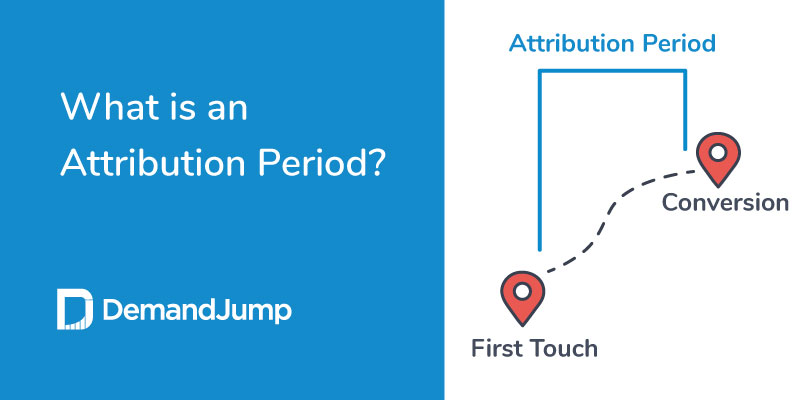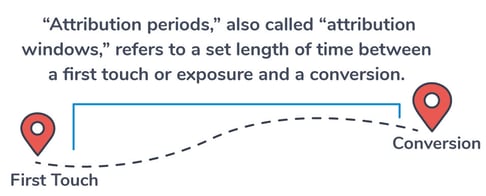What is an Attribution Period?
April 30, 2021 •DJ Team

Attribution periods play a major role in how advertising platforms set parameters around conversions.
If you advertise through major social media platforms, you may have noticed some buzz surrounding the recent Facebook attribution window update. This update is important for marketers who report on how they attribute credit to their ads and promoted content. In this example, “window” is exchangeable with “period”—whatever term you use, the topic at hand is all about setting timeframes for measuring your marketing impact.
What does attribution mean?
Let’s start by defining digital marketing attribution:
In practice, marketing attribution is the science of evaluating the impact that marketing touchpoints have on conversions.
In effect, attribution is your key to understanding exactly how your digital resources are contributing to your conversions, for better or worse. What makes marketing attribution such a powerful resource is the information you collect will directly lead you to make better choices on how to spend and distribute marketing resources while also increasing ROIs. Imagine every single post-campaign review looking better than the last?
While marketing attribution sounds straightforward, it can be a complex but rewarding measurement tool depending on the attribution methods, or models, that are deployed to configure the logic behind attributing credit among your many marketing channels, touchpoints, and exposures.
There are many ways to determine how and when to give credit to your individual campaign ads.
What is an attribution period?
The phrase “attribution periods,” also called “attribution windows,” refers to a set length of time between a first touch or exposure and conversion. For many advertisement platforms, like Facebook, attribution windows are used to determine the length of time that credit will still be given to those first touchpoints before being deemed as non-contributing exposures.

For example, up until January 2021, Facebook maintained a 28-day view attribution window that allowed a single first advertising exposure up to 28 days to inevitably lead to a conversion in order to claim credit for that conversion. On day 29, that first touchpoint would no longer be attributed credit for any conversion made.
Facebook’s recent update changed that 28-day window to the next largest window: 7 days. Reducing the previous largest window by three-fourths has created all that buzz you may have been noticing. This ultimately means that marketers are met with a new challenge of reduced metrics on the performance of their efforts. For many, this may also signal an impending disconnect between their reporting figures before and after the update.
Attribution methods
Attribution methods outline the strategy behind how your ads and promoted content receive credit for a conversion. While we’d like to think every piece of our ad efforts are working together to push users towards an action or conversion, determining how to assess the range and value of attribution can be a complex process.
Let’s take a look at some of the more common attribution methods deployed to capture and analyze the performance of your many different marketing channels.
First Click attribution model
First click attribution dictates that the very first touchpoint that a user interacts with, which ultimately leads to a conversion, is given full credit for that conversion. This is a single-touch attribution model that allows marketers to report on their performance even when they lack the resources to put together a model that is unique to their business.
Last click attribution model
Similar to First click attribution, last-click is also a single-touch attribution model that many marketers use as the default in order to accredit the very last touchpoint that led to a conversion.
Linear attribution model
Linear attribution models split credit among all touchpoints within a path to conversion. This method allows multiple exposures to be credited but fails to provide a holistic view of how each touchpoint contributed.
Weighted attribution model
Taking things a little deeper, weighted models allow marketers to apply weighted credit to each touchpoint based on its individual impact on the success of a conversion. Weighted models are typically the first big step to a complex, multi-touch attribution model but the initial attention to the framework logic will prove useful as you begin to note which channels and content types are and are not working.
Time decay attribution model
Facebook’s attribution window update regards a classic time decay attribution model that analyzes performance based upon a window of time between a touchpoint’s exposure and a conversion. If the first touchpoint was 28 days before conversion, this kind of model will allow you to apply a lesser amount of credit to that first touchpoint.
Custom, or data-driven, attribution models
Custom models rely on a framework of logic to dictate when and how to apply credit to exposures that are unique to an individual brand or business. Heavy initial lifting, but the rewards will provide a clear-cut picture of your individual touchpoints, channels, and content performance.\
In order for marketers to gather and report on attribution and campaign performance, they first need to understand how attribution periods factor into how credit is attributed among all of your marketing touchpoints and exposures.
It’s important to remember that there are options for measuring the performance of your ad resources with dedicated tools and data solutions. DemandJump’s attribution solutions enable you to define your own terms for accreditation, whether it’s with a simple method or a unique-to-you attribution model that will connect you to the exact data you’ve always wanted. Get a demo today and see how you can start eliminating poor-performing marketing exposures!
Featured Articles
Categories
- Attribution Tracking (13)
- Channel Optimization (11)
- Consumer Insights (68)
- Content Marketing (251)
- Data Science (8)
- Digital Marketing (6)
- Digital Transformation (26)
- Enterprise (10)
- Lead Generation (14)
- Market Intelligence (8)
- Marketing Analytics (39)
- Marketing Attribution (57)
- Marketing Management (153)
- Marketing Operations (86)
- Organic Search (222)
- Paid Search (52)
- Pillar-Based Marketing (63)
- Programmatic Advertising (9)
- SaaS Content (14)
- SaaS Marketing (29)
- Search Marketing (111)
- SEO Keyword Research (28)
- SEO Pillar (18)
- SEO Strategy (46)
- SMB (5)
- Website Content (12)

